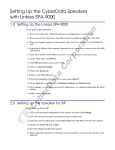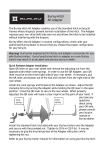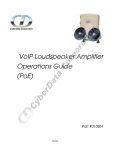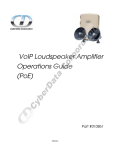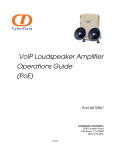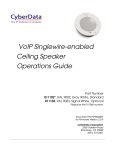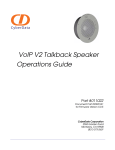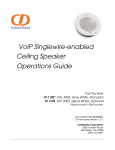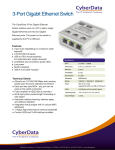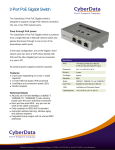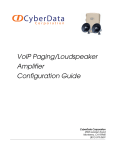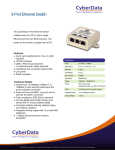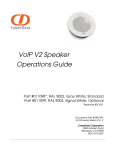Download CyberData VoIP Ceiling Speaker User's Manual
Transcript
VoIP Ceiling Speaker Operations Guide Part #010844 CyberData Corporation 2555 Garden Road Monterey, CA 93940 (831) 373-2601 930095H PoE VoIP Speaker Operations Guide 930095H Part # 010844 COPYRIGHT NOTICE: © 2007, CyberData Corporation, ALL RIGHTS RESERVED. This manual and related materials are the copyrighted property of CyberData Corporation. No part of this manual or related materials may be reproduced or transmitted, in any form or by any means (except for internal use by licensed customers), without prior express written permission of CyberData Corporation. This manual, and the products, software, firmware, and/or hardware described in this manual are the property of CyberData Corporation, provided under the terms of an agreement between CyberData Corporation and recipient of this manual, and their use is subject to that agreement and its terms. DISCLAIMER: Except as expressly and specifically stated in a written agreement executed by CyberData Corporation, CyberData Corporation makes no representation or warranty, express or implied, including any warranty or merchantability or fitness for any purpose, with respect to this manual or the products, software, firmware, and/or hardware described herein, and CyberData Corporation assumes no liability for damages or claims resulting from any use of this manual or such products, software, firmware, and/or hardware. CyberData Corporation reserves the right to make changes, without notice, to this manual and to any such product, software, firmware, and/or hardware. OPEN SOURCE STATEMENT: Certain software components included in CyberData products are subject to the GNU General Public License (GPL) and Lesser GNU General Public License (LGPL) “open source” or “free software” licenses. Some of this Open Source Software may be owned by third parties. Open Source Software is not subject to the terms and conditions of the CyberData COPYRIGHT NOTICE or software licenses. Your right to copy, modify, and distribute any Open Source Software is determined by the terms of the GPL, LGPL, or third party, according to who licenses that software. Software or firmware developed by CyberData that is unrelated to Open Source Software is copyrighted by CyberData, subject to the terms of CyberData licenses, and may not be copied, modified, reverse-engineered, or otherwise altered without explicit written permission from CyberData Corporation. TRADEMARK NOTICE: CyberData Corporation and the CyberData Corporation logos are trademarks of CyberData Corporation. Other product names, trademarks, and service marks may be the trademarks or registered trademarks of their respective owners. Phone: (831) 373-2601 Technical Support Ext. 333 [email protected] Fax: (831) 373-4193 Company and product information at www.cyberdata.net CyberData Corporation 930095H Operations Guide Revision History Revision Date Released Description of Changes E 11/08/2006 Adds Section 2.4, "Set up the MGROUPS". F 1/22/2007 Adds info about the RTFM Announcement feature in Table 2-6 G 4/12/2007 Changes the Authenticate ID and password character limit from 30 to 25 in Table 2-7. H 6/29/2007 Adds Figure 2, "Public Address System—Multicast" . Adds more information about MGROUPS in Section 2.4, "Set up the MGROUPS". Adds information about the Outbound Proxy in Table 2-7. CyberData Corporation 930095H Operations Guide CyberData Corporation 930095H Operations Guide i Contents Chapter 1 Product Overview 1 1.1 Typical System Installation ...................................................................................................................1 1.2 Product Features .....................................................................................................................................2 1.3 Supported Protocols ..............................................................................................................................3 1.4 Supported SIP Servers ...........................................................................................................................3 1.5 Product Specifications ...........................................................................................................................3 Chapter 2 Installing the VoIP Ceiling Speaker 5 2.1 Parts List ..................................................................................................................................................5 2.2 Speaker Setup .........................................................................................................................................6 2.2.1 Connect Power to the Speaker .................................................................................................6 2.2.2 Confirm that the Speaker is Operational and Linked to the Network ...............................7 2.2.3 Confirm the IP Address, Test the Audio, and Check the Volume .......................................8 2.2.4 Adjust the Volume ......................................................................................................................9 2.3 Configure the Speaker Parameters .....................................................................................................9 2.3.1 Log in to the Configuration Home Page ................................................................................10 2.3.2 Configure the Network Parameters ......................................................................................12 2.3.3 Set up the Speaker .....................................................................................................................14 2.3.4 Configure the SIP Parameters .................................................................................................15 2.4 Set up the MGROUPS ..........................................................................................................................18 2.5 Upgrade the Firmware and Reboot the Speaker .............................................................................20 2.5.1 Reboot the Speaker ..................................................................................................................22 2.6 Restore the Factory Default Settings .................................................................................................23 Appendix A Mounting the Speaker 25 A.1 Mount the Speaker .............................................................................................................................25 Appendix B Setting up a TFTP Server 29 B.1 Set up a TFTP Server ...........................................................................................................................29 B.1.1 In a LINUX Environment ........................................................................................................29 B.1.2 In a Windows Environment ...................................................................................................29 B.1.3 In a Solarwinds Server Environment ....................................................................................29 Appendix C Troubleshooting/Technical Support 31 C.1 Frequently Asked Questions (FAQ) .................................................................................................31 C.2 Documentation ....................................................................................................................................31 C.3 Contact Information ............................................................................................................................31 C.4 Warranty ...............................................................................................................................................32 Index Operations Guide 33 930095H CyberData Corporation ii CyberData Corporation 930095H Operations Guide 1 1 Product Overview The Voice-over-IP (VoIP) Ceiling Speaker uses a single cable to connect to existing LANs to broadcast digital audio over your public address system. The small footprint and low height makes this an ideal speaker to discreetly mount almost anywhere. 1.1 Typical System Installation Figure 1 illustrates how the VoIP Ceiling Speakers are normally installed as part of a public address system. Figure 1. Public Address System 802.3af PoE compliant Hub SIP Server PoE VoIP Speakers Operations Guide VoIP Phone 930095H CyberData Corporation 2 Product Overview Product Features Figure 2 illustrates how the VoIP Ceiling Speakers are can be installed as part of a multicast public address system. Figure 2. Public Address System—Multicast 1.2 Product Features CyberData Corporation 930095H ● SIP compliant ● Multicast support ● Dual speeds of 10 Mbps and 100 Mbps ● 802.3af compliant ● High efficiency speaker driver ● Web-based configuration ● External volume control ● Small footprint ● Web-based firmware upgrades Operations Guide Product Overview 3 Supported Protocols 1.3 Supported Protocols The IP Speaker supports: ● SIP ● Multicast ● HTTP Web-based configuration Provides an intuitive user interface for easy system configuration and verification of speaker operations. ● DHCP Client Dynamically assigns IP addresses in addition to the option to use static addressing. ● TFTP Client Facilitates Web-based firmware upgrades of the latest speaker capabilities. ● RTP ● RTP/AVP - Audio Video Profile ● Audio Encodings PCMU (G.711 mu-law) PCMA (G.711 A-law) Packet Time 20 ms 1.4 Supported SIP Servers The following link contains information on how to configure the speaker for the supported SIP servers: http://www.cyberdata.net/support/voip/ceilingspeaker.html 1.5 Product Specifications Operations Guide Category Specification Sensitivity 96dB/1W/1M S.P. Level Output 8 Watts Peak Power Port Baud Rate 10/100 Mbps Power Requirement 802.3af compliant Protocol SIP Part Number 010844 Dimensions 9" x 2.4" Weight 1.6 lbs./shipping weight of 2.5 lbs. 930095H CyberData Corporation 4 Product Overview Product Specifications CyberData Corporation 930095H Operations Guide 5 2 Installing the VoIP Ceiling Speaker 2.1 Parts List Table 2-1 illustrates the parts for each speaker and includes kits for the drop ceiling and drywall mounting. Note The Template for Speaker and Screw Holes is located on the last page of the Installation Quick Reference Guide that is included in the packaging with each speaker. Table 2-1. Parts List Operations Guide Quantity Part Name Illustration 1 Speaker Assembly 1 Installation Quick Reference Guide 1 Speaker Mounting Accessory Kit (Part #070054A) 930095H CyberData Corporation 6 Installing the VoIP Ceiling Speaker Speaker Setup 2.2 Speaker Setup Set up and configure each speaker before you mount it. CyberData delivers each speaker with the following factory default values: Table 2-2. Factory Default Settings—Default of SIP Parameter Factory Default Setting SIP/MGROUPS SIP IP Addressing static IP Address 192.168.3.10 Web Access Username admin Web Access Password admin Subnet Mask 255.255.255.0 Default Gateway 192.168.3.1 2.2.1 Connect Power to the Speaker Figure 2-1 and Figure 2-2 illustrates how to connect the VoIP Ceiling Speaker to a 802.3af compliant ethernet hub (Figure 2-1) or a PoE Injector (Figure 2-2) via a Cat 5 Ethernet Connector. Note If a 802.3af compliant ethernet hub is not available, you will need a PoE Injector, part #010867A (ordered separately). A PoE Injector is a power supply solution for those who have a standard hub. Figure 2-1. 802.3af Compliant Ethernet Hub Figure 2-2. PoE Injector PoE Injector (Part #010867A) Non PoE Hub CyberData Corporation 930095H Operations Guide Installing the VoIP Ceiling Speaker 7 Speaker Setup 2.2.2 Confirm that the Speaker is Operational and Linked to the Network After connecting the speaker to the 802.3af compliant ethernet hub, the LEDs on the speaker face confirm that the speaker is operational and linked to the network. Figure 2-3. Status and Activity LEDs Network Link/Activity (Yellow) Speaker Status (Green) 2.2.2.1 Status LED After supplying power to the speaker: 1. The green Status LED illuminates after approximately five seconds to indicate the start of the firmware verification and load process. 2. After approximately 15 seconds, the Status LED begins to blink at one second intervals to indicate the start of the firmware boot process. 3. After approximately 35 seconds, the speaker beeps once to indicate that it is operational. 4. The Status LED will continue to blink at one second intervals to indicate normal operation. 2.2.2.2 Link LED Operations Guide ● The Link LED is illuminated when the network link to the speaker is established. ● The Link LED blinks to indicate network traffic. 930095H CyberData Corporation 8 Installing the VoIP Ceiling Speaker Speaker Setup 2.2.3 Confirm the IP Address, Test the Audio, and Check the Volume When the speaker is operational and linked to the network, use the Reset Test Function Management (RTFM) switch (Figure 2-4) on the speaker face to announce and confirm the speaker’s IP Address, test that the audio is working, and check the volume. Figure 2-4. RTFM Switch RTFM switch To announce a speaker’s current IP address: 1. Press and hold the RTFM switch until it beeps (after one second). 2. Release the switch to hear the IP address announcement, and check the speaker volume. Note The speaker will announce it's default IP address (192.168.3.10). CAUTION Pressing and holding the RTFM switch for longer than 20 seconds will restore the speaker to the factory default settings. See Section 2.6, "Restore the Factory Default Settings". CyberData Corporation 930095H Operations Guide Installing the VoIP Ceiling Speaker 9 Configure the Speaker Parameters 2.2.4 Adjust the Volume To adjust the speaker volume, turn the Volume dial (Figure 2-5) on the speaker face. Figure 2-5. Volume Control Volume control 2.3 Configure the Speaker Parameters To configure the speaker online, use a standard web browser. Configure each speaker and verify its operation before you mount it. When you are ready to mount a speaker, refer to Chapter A, “Mounting the Speaker” for instructions. All speakers are initially configured with the following default IP settings: When configuring more than one speaker, attach the speakers to the network and configure one at a time to avoid IP address conflicts. Table 2-3. Factory Default Settings Operations Guide Parameter Factory Default Setting SIP/MGROUPS SIP IP Addressing static IP Address 192.168.3.10 930095H CyberData Corporation 10 Installing the VoIP Ceiling Speaker Configure the Speaker Parameters Table 2-3. Factory Default Settings (continued) Parameter Factory Default Setting Web Access Username admin Web Access Password admin Subnet Mask 255.255.255.0 Default Gateway 192.168.3.1 2.3.1 Log in to the Configuration Home Page 1. Open your browser to the speaker IP address. For the initial configuration of the speaker, open your browser to the default IP address: http://192.168.3.10 Note Make sure that the PC is on the same IP network as the speaker. 2. When prompted, use the following default Web Access Username and Web Access Password to access the Home Page (Figure 2-6): Web Access Username: admin Web Access Password: admin Figure 2-6. Home Page SIP CyberData Corporation 930095H Operations Guide Installing the VoIP Ceiling Speaker 11 Configure the Speaker Parameters 3. On the Home Page, review the setup details and navigation buttons described in Table 2-4. Table 2-4. Home Page Overview Web Page Item Description Device Name Shows the device name. Running Shows the current speaker function. Serial # Device serial number. Ethernet Address Device ethernet address. IP Addressing Shows the current IP addressing setting (DHCP or static). IP Address Shows the current IP address. Subnet Mask Shows the current subnet mask address. Default Gateway Shows the current default gateway address. Link to the Speaker Setup web page. Link to the Network Setup web page. Link to the SIP Setup web page. Link to the MGROUPS Setup page. Link to the Upgrade Firmware web page. Operations Guide 930095H CyberData Corporation 12 Installing the VoIP Ceiling Speaker Configure the Speaker Parameters 2.3.2 Configure the Network Parameters 1. Click the Network Setup button to open the Network Setup page (Figure 2-7). Figure 2-7. Network Setup Page 2. On the Network Setup page, enter values for the parameters indicated in Table 2-5. Table 2-5. Network Setup Parameters Web Page Item Description IP Addressing* Select either DHCP IP Addressing or Static IP Addressing by marking the appropriate radio button. If you select Static, configure the remaining parameters indicated in Table 2-5. If you select DHCP, go to Step 3. IP Address* Enter the Static IP address. Subnet Mask Enter the Subnet Mask address. Default Gateway Enter the Default Gateway address. DNS Server 1* Enter the DNS Server 1 address. DNS Server 2* Enter the DNS Server 2 address. Click this button to save your configuration settings. Changing a parameter that has an asterisk next to it will cause a system reboot when saved. CyberData Corporation 930095H Operations Guide Installing the VoIP Ceiling Speaker 13 Configure the Speaker Parameters Table 2-5. Network Setup Parameters (continued) Web Page Item Description Link to the Speaker Setup page. Link to the SIP Setup page. Link to the MGROUPS Setup page. Link to the Upgrade Firmware page. Link to the Home page. 3. After changing the parameters, click Save Settings. This updates the changed parameters and reboots the speaker if appropriate. 4. Connect the speaker to the target network. 5. From a system on the same network as the speaker, open a browser with the new IP address of the speaker. Operations Guide 930095H CyberData Corporation 14 Installing the VoIP Ceiling Speaker Configure the Speaker Parameters 2.3.3 Set up the Speaker 1. Click the Speaker Setup button to open the Speaker Setup page. See Figure 2-8. Figure 2-8. Speaker Setup 2. On the Speaker Setup page, enter values for the parameters indicated in Table 2-6. Table 2-6. Speaker Setup Parameters Web Page Item Description Device Name Enter a descriptive name for this device (if desired). Select Speaker Function Select SIP or MGROUPS. Change Web Access Username Use this field to change the Web Access Username Change Web Access Password Use this field to change the Web Access Password Re-enter New Password Use this field to re-enter a new password Speaker Tone Before Paging Enable/Disable the speaker tone (beep) before each page. Speaker Tone After Initialization Enable/Disable the speaker tone (beep) after the system startup. CyberData Corporation 930095H Operations Guide Installing the VoIP Ceiling Speaker 15 Configure the Speaker Parameters Table 2-6. Speaker Setup Parameters (continued) Web Page Item RTFM Announcement Description a Enable/Disable the speaker tone (beep) and audio associated with the RTFM switch. Click on this button to save your configuration settings. Click on this button to do an audio test. Generates a voice message for testing the speaker audio quality and volume. Link to the Network Setup page. Link to the SIP Setup page. Link to the MGROUPS Setup page. Link to the Upgrade Firmware page. Link to the Home page. a.If you select No for RTFM Announcement, you will not hear a beep or associated RTFM audio. However, the return to default settings function remains active. If you wish to return to default settings, hold the RTFM button at least 20 seconds, then release the button. 3. After changing the parameters, click Save Settings. 2.3.4 Configure the SIP Parameters 1. Click SIP Setup to open the SIP Setup page (Figure 2-9). Note For specific server configurations, go to the following URL: http://www.cyberdata.net/support/voip/ceilingspeaker.html Note Operations Guide If the speaker is set up for MGROUPS, the SIP settings will be grayed out. 930095H CyberData Corporation 16 Installing the VoIP Ceiling Speaker Configure the Speaker Parameters Figure 2-9. SIP Setup Page CyberData Corporation 930095H Operations Guide Installing the VoIP Ceiling Speaker 17 Configure the Speaker Parameters 2. On the SIP Setup page, enter values for the parameters indicated in Table 2-7. Table 2-7. SIP Setup Parameters Web Page Item Description SIP Server* Enter the SIP server represented as either a numeric IP address in dotted decimal notation or the fully qualified host name (FQHN) up to 64 characters. Outbound Proxy Enter the Outbound Proxy as either a numeric IP address in dotted decimal notation or the fully qualified host name (FQHN) up to 64 characters. Remote SIP Port* Enter the Remote SIP Port number (default 5060). Local SIP Port* Enter the Local SIP Port number (default 5060). SIP User ID* Enter the SIP User ID (up to 25 alphanumeric characters). Authenticate ID* Enter the Authenticate ID (up to 25 alphanumeric characters). Authenticate Password* Enter the Authenticate Password (up to 25 alphanumeric characters). SIP Registration* Enable/Disable SIP Registration. Unregister on Reboot* • Select Yes to automatically unregister the speaker when it is rebooted. • Select No to keep the speaker registered when it is rebooted. Register Expiration* Enter the SIP Registration lease time in minutes (default 60 minutes). Click this button to save your configuration settings. Changing a parameter that has an asterisk next to it will cause a system reboot when saved. Link to the Speaker Setup page. Link to the MGROUPS Setup page. Link to the Network Setup page. Link to the Upgrade Firmware page. Link to the Home page. 3. After changing the parameters, click Save Settings. Operations Guide 930095H CyberData Corporation 18 Installing the VoIP Ceiling Speaker Set up the MGROUPS 2.4 Set up the MGROUPS MGROUPS uses multicasting to create Public Address Paging Zones. Multicasting is based on the concept of a group. Multicast addresses specify an arbitrary group of IP hosts that have joined the group and want to receive traffic sent to the group. Group members send IGMP messages to their local multicast routers, allowing the group traffic traversal from the source. MGROUPS Setup provides the ability to join up to 10 Paging Zones. A Paging Zone can consist of one, or many, CyberData MGROUPS-enabled speakers. There is no limit to how many speakers can be in a given Paging Zone. Each MGROUP is defined by a multicast address and port number. Each MGROUP is also assigned a priority, allowing simultaneously arriving pages to be serviced based on importance. MGROUPS are compatible with IGMP through version 3. 1. Click on the MGROUPS Setup button to open the MGROUPS Setup page. See Figure 2-10. Figure 2-10. MGROUPS Setup CyberData Corporation 930095H Operations Guide Installing the VoIP Ceiling Speaker 19 Set up the MGROUPS 2. On the MGROUPS Setup page, enter values for the parameters indicated in Table 2-8. Table 2-8. MGROUPS Setup Parameters Web Page Item Description Device Name Displays the device name. MG-Emergency Use MG-Emergency for the MGROUP with the highest priority. MG-(1-8) Use MG-(1-8) to assign MGROUPS 1 through 8. MG-Background Use MG-Background for the MGROUP with the lowest priority (background audio for example). Multicast IP Address Enter the multicast IP Address for this MGROUP. Port 2000-65535 Enter the port number for this MGROUP. Priority Assign the priority for this MGROUP (the higher the number, the higher the priority). MGROUP Name Assign a descriptive name for this MGROUP. Beep Check this box if you want a beep to precede a page. Click this button to save your configuration settings. Click this button to reboot the system. Link to the Network Setup page. Link to the Speaker Setup page. Link to the SIP Setup page. Link to the Upgrade Firmware page. Link to the Home page. 3. After changing the parameters, click Save Settings. Note Operations Guide For information on how to set up MGROUPS in Cisco Call Manager Express, see Appendix D, “Setting Up MGROUPS in Cisco Call Manager Express”. 930095H CyberData Corporation 20 Installing the VoIP Ceiling Speaker Upgrade the Firmware and Reboot the Speaker 2.5 Upgrade the Firmware and Reboot the Speaker To upload the speaker firmware from your PC: 1. Set up a TFTP server. If you do not already have a TFTP server running on your network, see Appendix B, “Setting up a TFTP Server”. 2. Retrieve the latest speaker firmware from the CyberData website: http://www.cyberdata.net/support/voip/ceilingspeaker.html 3. Unzip the speaker version file. This file may contain the following: • Kernel firmware file: xxx-image-xxx-xxx.bin • Application firmware file: xxx-romdisk-xxx-xxx.img • Release notes 4. Copy the firmware files to be upgraded to the appropriate TFTP server directory: • c:\tftp-root\for Windows • /tftpboot/for Linux 5. Log in to the speaker home page as instructed in Section 2.3.1, "Log in to the Configuration Home Page". 6. Click the Upgrade Firmware button to open the Firmware Upgrade page. See Figure 2-11. CyberData Corporation 930095H Operations Guide Installing the VoIP Ceiling Speaker 21 Upgrade the Firmware and Reboot the Speaker Figure 2-11. Firmware Upgrade Page 7. Enter the IP address of your TFTP server into the TFTP Server IP parameter field. 8. Enter the firmware filename of the file to be uploaded into the New Filename parameter field. For example, kernel filename "201-image-spk-sip.bin". 9. Click Upload File. Note This starts the upload process. Once the speaker has uploaded the file, the Uploading Firmware countdown page appears, indicating that the firmware is being written to flash. The speaker will automatically reboot when the upload is complete. When the countdown finishes, the Firmware Upgrade page will refresh. The uploaded firmware filename should be displayed in the system configuration (indicating successful upload and reboot). 10. Repeat steps 8 and 9 if you are uploading the Kernel and Application files. For example, Application filename "201-romdisk-spk-sip.img". Table 2-9 shows the web page items on the Firmware Upgrade page. Table 2-9. Firmware Upgrade Parameters Operations Guide Web Page Item Description System Configuration Shows the current configuration. Bootname Shows the current boot loader filename. Kernel Shows the current kernel filename for partition 1 and 2. 930095H CyberData Corporation 22 Installing the VoIP Ceiling Speaker Upgrade the Firmware and Reboot the Speaker Table 2-9. Firmware Upgrade Parameters (continued) Web Page Item Description Application Shows the current application filename for partition 1 and 2. TFTP Server IP address Enter the TFTP Server IP address. New Filename Use this field to enter the new file name for the kernel or application firmware file that you are uploading. Click on this button to automatically upload the selected firmware and reboot the system. Link to the Speaker Setup page. Link to the Network Setup page. Link to go to the SIP Setup page. Link to the MGROUPS Setup page. Link to the Home page. Click on this button to reboot the system. 2.5.1 Reboot the Speaker To reboot a speaker, log in to the web page as instructed in Section 2.3.1, "Log in to the Configuration Home Page". 1. Click Upgrade Firmware to open the Firmware Upgrade page (Figure 2-12). CyberData Corporation 930095H Operations Guide Installing the VoIP Ceiling Speaker 23 Restore the Factory Default Settings Figure 2-12. Reboot System Section 2. Click Reboot. A normal restart will occur as per Section 2.2.2.1, "Status LED". 2.6 Restore the Factory Default Settings When troubleshooting configuration problems, it is sometimes convenient to restore the device to a known state. Each speaker is delivered with factory set default values for the parameters indicated in Table 2-10. Use the RTFM switch on the speaker face to restore these parameters to the factory default settings. Note When you use the RTFM switch, the factory default settings are restored for only the parameters indicated in Table 2-10. The other parameters in the current speaker configuration will remain unchanged. Table 2-10. Factory Default Settings Operations Guide Parameter Factory Default Setting IP Addressing static IP Address 192.168.3.10 Web Access Username admin Web Access Password admin Subnet Mask 255.255.255.0 930095H CyberData Corporation 24 Installing the VoIP Ceiling Speaker Restore the Factory Default Settings Table 2-10. Factory Default Settings (continued) Parameter Factory Default Setting Default Gateway 192.168.3.1 To restore these parameters to the factory default settings: 1. Press and hold the RTFM switch for 20 seconds. 2. The speaker will beep after one second. Continue to hold the switch until the speaker beeps again after 20 seconds. 3. Release the switch. The following occurs: • A voice message announces that the factory default settings are being restored. • Once the settings are restored, a voice message announces the restored default IP address: 192.168.3.10 CyberData Corporation • A voice message announces that the speaker is rebooting. • The speaker reboots. 930095H Operations Guide 25 Appendix A: Mounting the Speaker A.1 Mount the Speaker Before you mount the speaker, make sure that you have received all the parts for each speaker. Refer to Table A-1 and Table A-2. Table A-1. Drop Ceiling Mounting Components (Part of the Accessory Kit) Quantity Part Name 3 #8 Nylon Thumb Nuts 3 #8 Fender Washers 3 8-32 x 1 1/4" Mounting Screws Illustration Table A-2. Drywall Mounting Components (Part of the Accessory Kit) Quantity Part Name 3 Plastic Ribbed Anchors 3 #6 Sheet Metal Screws Illustration To mount the speaker: 1. Use the TEMPLATE to cut the speaker hole and prepare holes for the screws (Figure A-1). This template is located on the back page of the Installation Quick Reference Guide that is delivered with each speaker. Operations Guide 930095H CyberData Corporation 26 Mount the Speaker Figure A-1. VoIP Speaker Assembly VoIP SPEAKER ASSEMBLY DRY WALL MOUNTING KIT PLASTIC RIBBED ANCHOR (3x) #8 NYLON THUMBNUT (3X) #8 FENDER WASHER (3X) 3 16 120° " HOLE (3x) 3 8" CEILING 120° 7 41 " HOLE TEMPLATE VoIP SPEAKER ASSEMBLY MOUNTING SCREW 8-32x1 1/4" (3X) DRY WALL MOUNTING KIT #6 SCREW (3x) 080169B.dwg 2. Plug the Ethernet cable into the Speaker Assembly. Section 2.2.2, "Confirm that the Speaker is Operational and Linked to the Network" explains how the Link and Status LEDs work. 3. At this point: CyberData Corporation • For drop ceiling mounting, position the VoIP SPEAKER ASSEMBLY in the ceiling so that its screw holes align with those you prepared. • For drywall mounting, place the three PLASTIC RIBBED ANCHORS in the holes you prepared, and position the VoIP SPEAKER ASSEMBLY over them, aligning the screw holes in the assembly with the anchors. 930095H Operations Guide 27 Mount the Speaker 4. To fasten the speaker: Operations Guide • For drop ceiling mounting, use the three 8-32 x 1 1/4" MOUNTING SCREWS, #8 NYLON THUMB NUTS, and #8 FENDER WASHERS to secure the speaker. • For drywall mounting, use the three #8 SHEET METAL SCREWS to secure the speaker. 930095H CyberData Corporation 28 Mount the Speaker CyberData Corporation 930095H Operations Guide 29 Appendix B: Setting up a TFTP Server B.1 Set up a TFTP Server Upgrading the VoIP Ceiling Speaker firmware requires a TFTP server on which you access the Web interface where you can upload the firmware files. B.1.1 In a LINUX Environment To set up a TFTP server on LINUX: 1. Create a directory dedicated to the TFTP server, and move the files to be uploaded to that directory. 2. Run the following command where /tftpboot/ is the path to the directory you created in Step 1: the directory that contains the files to be uploaded. For example: in.tftpd -l -s /tftpboot/your_directory_name B.1.2 In a Windows Environment You can find several options online for setting up a Windows TFTP server. This example explains how to use the Solarwinds freeware TFTP server, which you can download at: http://www.tucows.com/preview/326445 To set up a TFTP server on Windows: 1. Install and start the software. 2. Select File/Configure/Security tab/Transmit Only. 3. Make a note of the default directory name, and then move the firmware files to be uploaded to that directory. B.1.3 In a Solarwinds Server Environment You can find several options online for setting up a Solarwinds server. This example explains how to use the Solarwinds freeware TFTP server, which you can download at: http://www.CyberData.net/support/voip Operations Guide 930095H CyberData Corporation 30 Set up a TFTP Server CyberData Corporation 930095H Operations Guide 31 Appendix C: Troubleshooting/Technical Support C.1 Frequently Asked Questions (FAQ) Go to the following URL to see CyberData’s list of frequently asked questions: http://www.CyberData.net/support/voip C.2 Documentation The documentation for this product is released in an English language version only. You can download PDF copies of CyberData product documentation at: www.CyberData.net—>Support—>Drivers, Utilities & Manuals—>VoIP Products C.3 Contact Information Contact CyberData Corporation 2555 Garden Road Monterey, CA 93940 USA www.CyberData.net Phone: 800-CYBERDATA (800-292-3732) Fax: 831-373-4193 Sales Sales 831-373-2601 Extension 334 Technical Support Phone: 831-373-2601 Extension 333 Email: [email protected] Returned Materials Authorization To return the product, contact the CyberData Returned Materials Authorization (RMA) department at: Phone: 831-373-2601, Extension 136 Email: [email protected] When returning a product to CyberData, an approved CyberData RMA number must be printed on the outside of the original shipping package. No product will be accepted for return without an approved RMA number. Send the product, in its original package, to the following address: CyberData Corporation 2555 Garden Road Monterey, CA 93940 Attention: RMA "your RMA number" Operations Guide 930095H CyberData Corporation 32 Warranty C.4 Warranty CyberData warrants its product against defects in material or workmanship for a period of two years from the date of purchase. Should the product fail within the warranty period, CyberData will repair or replace the product free of charge. This warranty includes all parts and labor. If the product is out-of-warranty and fails, a flat rate repair charge of one half the product purchase price will be assessed. Repair costs for products that are in warranty, but damaged by improper modifications or abuse, will be charged at the out-of-warranty rate. Products returned to CyberData, both in and out-of-warranty, are shipped to CyberData at the expense of the customer. Charges for shipping repaired products back to the customer will be paid by CyberData. CyberData Corporation 930095H Operations Guide 33 Index default gateway 6, 10, 12, 24 default IP settings 9 default login address 10 default speaker settings 23 DHCP Client 3 DHCP IP addressing 12 dimensions 3 DNS server 12 drop ceiling mounting of speaker 26 drywall mounting of speaker 26 Symbols #8 fender washers 25, 27 #8 nylon thumb nuts 25, 27 #8 sheet metal screws 25, 27 Numerics 802.3af compliant ethernet hub 6 8-32 x 1 1/4" mounting screws 25, 27 E A ethernet cable 26 ethernet hub 6 expiration time for SIP server lease 17 address, configuration login 10 adjusting volume 8 announcing a speaker’s IP address 8, 19 asterisk 12 audio encodings 3 audio test 8 F factory default settings 23 firmware upgrades 29 C G changing the web access password 14 configurable parameters 11, 12, 14, 17, 21 configuration default IP settings 9 network 12 SIP 15 using Web interface 9 configuration home page 10 confirming IP address 8 CyberData contact information, corporate, sales, tech support, service 31 green LED, status 7 H home page 10 http web-based configuration 3 I illustration of speaker mounting process 25 installation, typical speaker system 1 IP address 6, 9, 12, 22, 23 IP addressing 12 default setting 9, 23 D default gateway 6, 10, 24 IP address 6, 9, 23 speaker settings 33 subnet mask 6, 10, 23 username and password 6, 10, 23 web login username and password 10 Operations Guide 930095H CyberData Corporation 34 L port local SIP 17 remote SIP 17 port baud rate 3 power requirement 3 power, connecting to speaker 6 product configuring 9 mounting 25 parts list 5 product features 2 product overview product features 2 product specifications 3 supported protocols 3 supported SIP servers 3 typical system installation 1 product specifications 3 protocols supported 3 lease, SIP server expiration time 17 link LED 26 Linux, setting up a TFTP server on 29 local SIP port 17 log in address 10 M MGROUP MG-(1-8) 19 MG-Background 19 MG-Emergency 19 MGROUP Name 19 Multicast IP Address 19 mounting a speaker 25 Multicast 3 R N reboot 22, 24 registration and expiration, SIP server lease 17 remote SIP port 17 reset test function management switch 8 resetting the IP address to the default 25, 31 restoring factory default settings 23, 33 RMA returned materials authorization 31 RTFM switch 8, 23 RTP/AVP 3 network configuration of speaker 12 network link activity, verifying 7 Network Setup 12 O outbound proxy 17 output 3 S P sensitivity 3 server address, SIP 17 setting up a speaker 6 setting up a TFTP server 29 settings, default 23 SIP (session initiation protocol) 3 SIP Configuration 15 SIP configuration SIP Server 17 SIP registration 17 SIP server 17 SIP servers supported 3 speaker configuration default IP settings 9 speaker configuration page configurable parameters 11, 12, 14, 17, 21 speaker operations, verifying 14 Speaker Setup 14 packet time 3 part number 3 parts #8 fender washers 25 #8 nylon thumb nuts 25 #8 sheet metal screws 25 8-32 x 1 1/4" mounting screws 25 plastic ribbed anchors 25 parts list 5 password changing for web configuration access 14 for SIP server login 17 login 10 restoring the default 6, 10, 23 plastic ribbed anchors 25, 26 PoE Injector 6 CyberData Corporation 930095H Operations Guide 35 static IP addressing 12 status LED 7, 26 subnet mask 6, 10, 12, 23 supported protocols 3 T technical support, contact information 31 template for speaker and screw holes 25 testing audio 8 TFTP server 3, 29 U unregister, from SIP server 17 user ID for SIP server login 17 user ID, SIP 17 username changing for web configuration access 14 default for web configuration access 10 restoring the default 6, 10, 23 V verifying network link and activity 7 power on to speaker 7 speaker operations 14 VoIP speaker assembly 26 volume, adjusting 8 W warranty 32 web access password 6, 10, 23 web access username 6, 10, 23 web configuration log in address 10 web-based speaker configuration 9 weight 3 Windows, setting up a TFTP server on 29 Operations Guide 930095H CyberData Corporation 36 CyberData Corporation 930095H Operations Guide










































